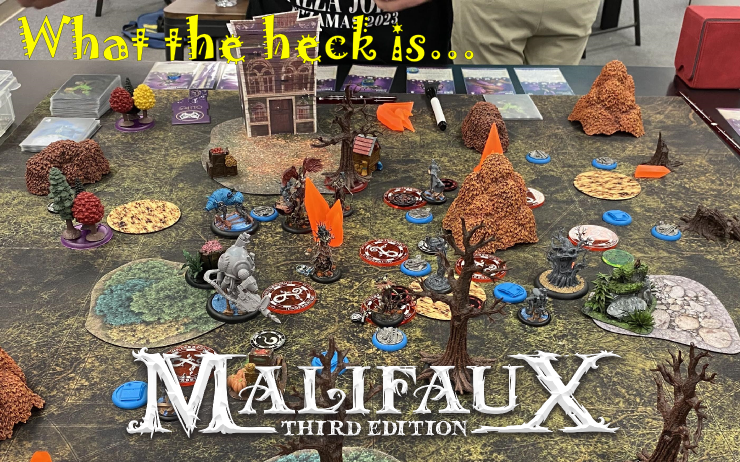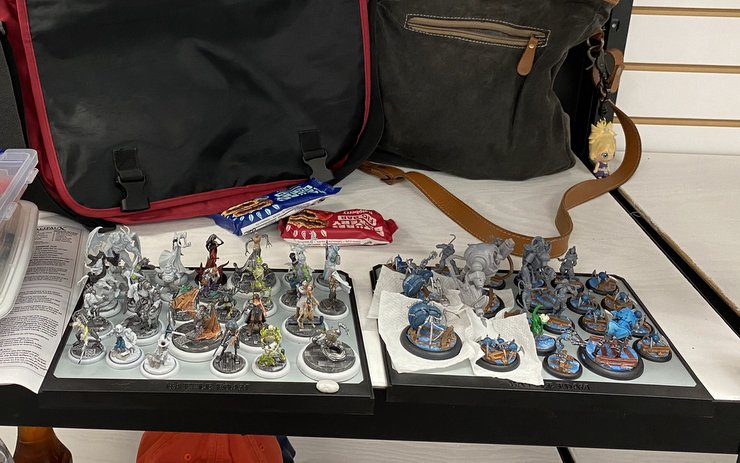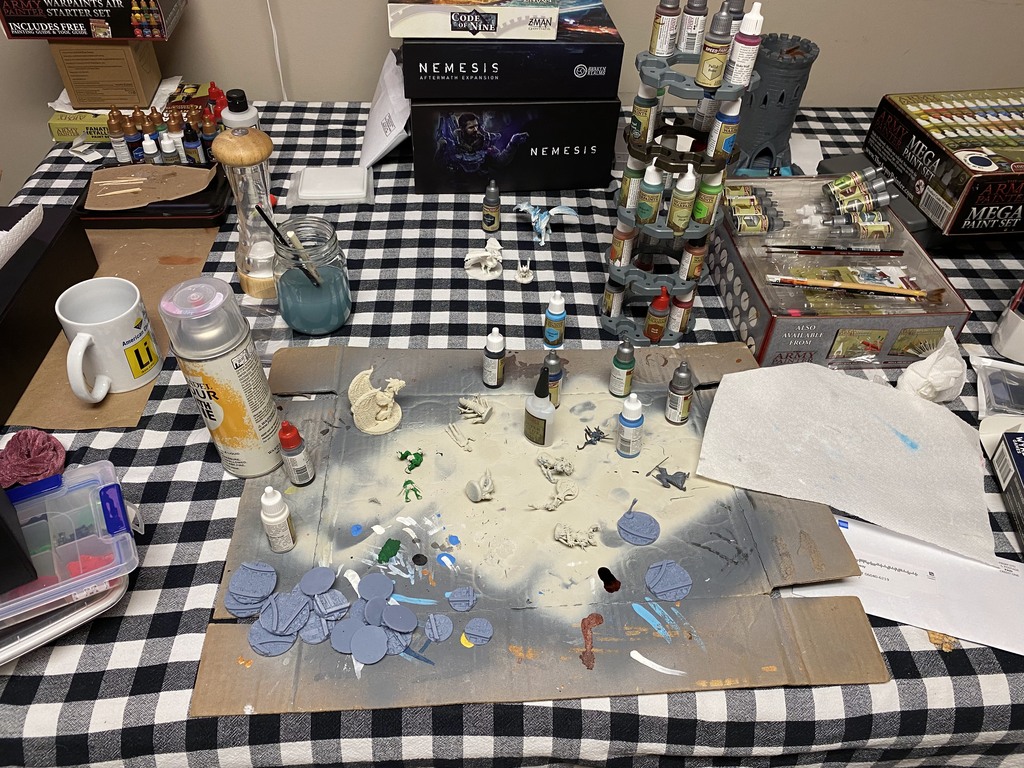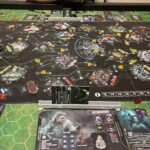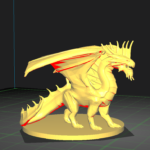At some point a couple hundred years ago, a mysterious portal to another world — Malifaux — appeared. A world of magic; magic that could be brought to Earth in the form of Soulstones.
There was already life in Malifaux before we came to take their land and steal their power, as we tend to do. In Malifaux, even normal humans had access to arcane powers; and some people had far more than their share. Those people were called Masters.
The humans are split into eight warring factions; chief among them is the Guild, an autocratic faction that imposes peace and order upon Malifaux city. Their peace, their order. Within each faction, Masters and their followers jockey for influence and power.
When talks and negotiation fail, the Masters must work out their disagreements on the battlefield. They each gather their crews and meet, with their strategies and schemes.
Each Master has one or more factions and one or more keywords. Keywords are grouping withing a faction; my Master, Mei Feng (Foreman), is a member of both the Arcanist and Ten Thunders factions. But importantly, she has the keyword Foundry, as she leads the metalworkers union.
In a normal game, all masters can bring along any unit that shares a keyword with the master, if they can pay the cost. (Normal games give 50 soulstones, and every crew member has a cost, aside from the Master and her minion). They can also hire “versatile” models, as long as they are in the same faction. They are assumed to share a keyword with the master. Models that are in the same faction but are not versatile and do not share a keyword cost an additional soulstone fee.
Mei Feng, as a master, supports her crew by giving them helpful conditions and giving the enemy bad conditions. As a master, she gets three actions per turn, as well as a bonus action which lets her throw scrap markers on enemy units to damage them.
Like almost everything in the Foundry keyword, she has Ride the Rails, an ability that lets the unit travel from one scrap marker to another within 12 inches, giving the keyword good mobility.
Keywords are everything in Malifaux. And there are a lot of keywords, and each one plays very differently. I hardly know any of them.
Strategies and Schemes
Malifaux is not about engaging an enemy crew and killing them all. You don’t gain any points for killing enemies. Points are scored with strategies and schemes.
A Strategy is the particular match’s objective. A common one in “Plant Explosives”, where certain members of your crew are carrying bombs, which must be delivered to the opponent’s side of the table. At the end of the game, if you have two on their side of the table, ten inches or more apart, you win a point. You can pick up explosives dropped on the ground, and if you kill an enemy unit carrying a bomb, you can grab those as well. You could deny your opponent this Strategy just by following them and picking up the explosives they drop.
Each game starts with a randomly chosen pool of six Schemes. These are similar to Strategies, except they are secret. Two are chosen by each player, and then they work openly on the Strategy and secretly on their Schemes. Figuring out the opponent’s schemes so that you can deny them points is part of the game.
Battles between units — duels — are an important part of the match, but it’s rare for a duel to end with a unit dying. More often, duels allow you to move an enemy unit elsewhere or deny it an objective.
My Crew
My master is Mei Feng, Foreman — the title version of her model. I previously played with her non-title version, from before she became Foundry head and she had different abilities. She has a companion, the Forgeling, a fire creature who sets things on fire and drops scrap markers.
Kang is her second in command, a tanky fighter who powerfully encourages people near him and does a fair amount of damage both close in and at range. He is aided by two Rail Workers who can toss friendly and enemy units around the play area with their mechanical limbs.
I’ve thought that when you join the Foundry, you’re not really one of the crew until you’ve lost at least one limb. All the Foundry keyword models are at least partly constructs, including Mei Feng herself. When they die, they can leave scrap markers or corpse markers.
The rest of the crew are constructs — Mechanical Porkchop, a huge boar that crashes through enemies, is my striker. Metal Golem is a huge, tanky construct that I use for area control. And Gearling is a little all-terrain bot that can weave through hostile terrain and hostile mobs and is perfect for breaking through opponent front lines.
The Tournament
Saturday’s tournament was three games. The layouts, strategies and scheme pools were posted in advance so that people would be able to set up their crews.
My first match was against a lady using the Bayou (greenskin) faction and the Tricksy keyword. Both Tricksy and Foundry use scrap markers; hers to make into traps, mine to “ride the rails” and travel between them. It made for a lot of scrap markers on the field, especially with the enemy ability to make all traps into scrap markers and vice versa. This got us a few spectators wondering how this would play out — two faction/keywords that had so much in common, battling. We were both new, so we only got through one full move and part of a second before we ran out of time — two and a half hours. Malifaux is not a fast game. She won, 2-1.
I had a bye for the second match, so I played a training game against one of the tournament organizers. He ran Leviticus, Pariah of Blood — Outcasts faction with the Horseman keyword, which gave him a lot of mobility. That keyword is based around gaining and spending Fate tokens, which increase each turn. I also lost this game, but since it was a bye, I was marked as winning.
Last match was against Titania, Autumn Queen — Neverborn faction with the Fae keyword. This allowed Titania to spread auras to any of her units within line of sight, and let her attack through some of her lieutenants as if she were there herself. I did better this game, focusing on strategies and schemes, and managed three points to his five.
I didn’t do well in the tournament, just second lowest, but second lowest isn’t lowest, so I call it a win of sorts.
Should you play Malifaux?
If you like games like Warhammer 40K, Battletech, or similar other miniatures games, you might enjoy the vast number of faction/keyword combinations that let you build a unique crew with a lot of history behind the units (each faction has a book that runs through the faction’s storyline).
It’s an expensive game just to buy the minis and the stuff you need to play, though there are core boxes that will have most of the stuff you need, and there’s an app for the game which can take the place of most of the various condition markers and stuff. The app is how you start matches; it can help choose the strategies, scheme pools and layouts.
There are no dice in Malifaux; randomness is done with a standard deck of playing cards, though you can get decks themed to your faction (and the core boxes include such a deck). It all comes down to the minis. They largely come unassembled and unpainted. Putting them together can be a chore. Models don’t need to be painted; only some of mine are.
I have some models that are all painted and ready to go, but as I tune my team, those models largely are on the sidelines. I think they are cool, but they didn’t synergize well with the Foundry keyword. My conception was Mei Feng at the head of a parade of mechanical monsters, but, she needed the support of the rank and file more.
It’s a fun game. It takes a lot of time. If Kasul weren’t into it, I doubt I’d bother, but it is something we can do together and his enthusiasm is contagious. I did have a lot of fun at the tournament and can’t wait for the next one, some time in the fall.
I’ll probably have more of my crew painted by then. A new league starts tomorrow, so I may have another chance to lose play very soon.
